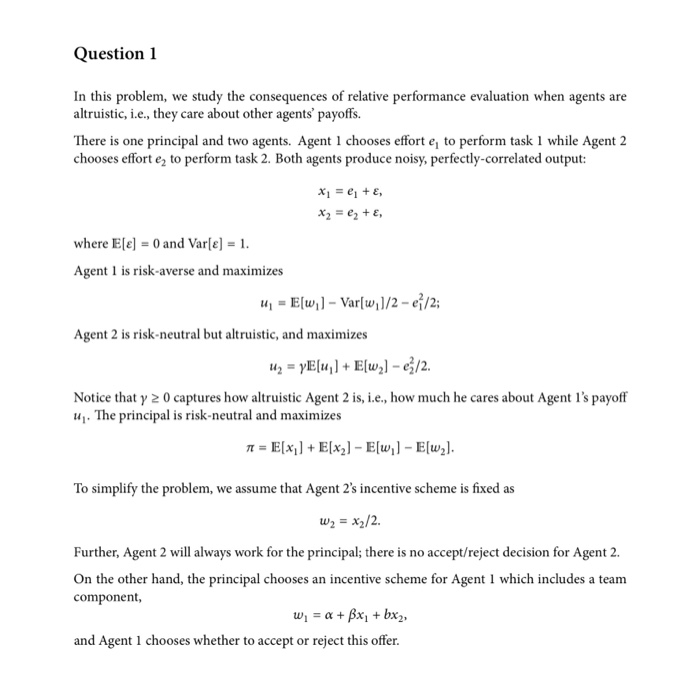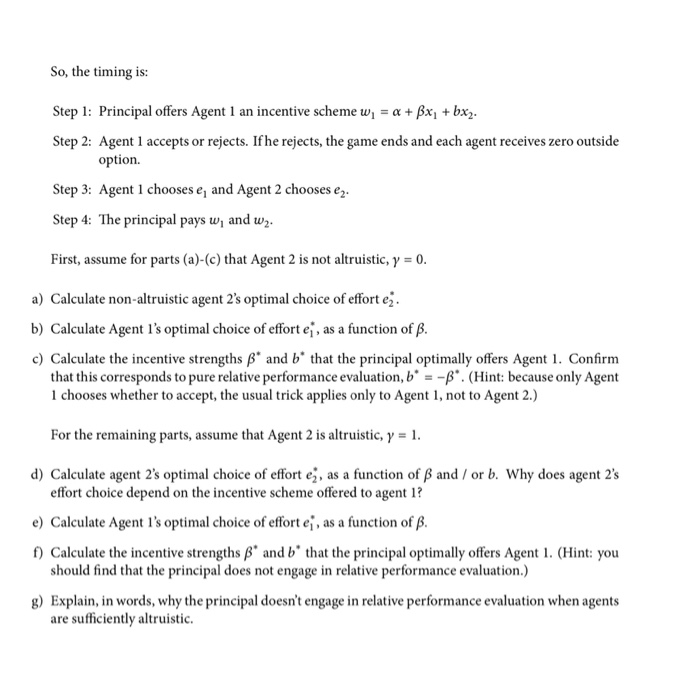

In this problem, we study the consequences of relative performance evaluation when agents are altruistic, i.e., they care about other agents' payoffs. There is one principal and two agents. Agent 1 chooses effort e1 to perform task 1 while Agent 2 chooses effort e2 to perform task 2 . Both agents produce noisy, perfectly-correlated output: x1=e1+,x2=e2+, where E[]=0 and Var[]=1. Agent 1 is risk-averse and maximizes u1=E[w1]Var[w1]/2e12/2 Agent 2 is risk-neutral but altruistic, and maximizes u2=E[u1]+E[w2]e22/2 Notice that 0 captures how altruistic Agent 2 is, i.e., how much he cares about Agent 1's payoff u1. The principal is risk-neutral and maximizes =E[x1]+E[x2]E[w1]E[w2]. To simplify the problem, we assume that Agent 2's incentive scheme is fixed as w2=x2/2. Further, Agent 2 will always work for the principal; there is no accept/reject decision for Agent 2. On the other hand, the principal chooses an incentive scheme for Agent 1 which includes a team component, w1=+x1+bx2, and Agent 1 chooses whether to accept or reject this offer. So, the timing is: Step 1: Principal offers Agent 1 an incentive scheme w1=+x1+bx2. Step 2: Agent 1 accepts or rejects. If he rejects, the game ends and each agent receives zero outside option. Step 3: Agent 1 chooses e1 and Agent 2 chooses e2. Step 4: The principal pays w1 and w2. First, assume for parts (a)-(c) that Agent 2 is not altruistic, =0. a) Calculate non-altruistic agent 2 's optimal choice of effort e2. b) Calculate Agent 1's optimal choice of effort e1, as a function of . c) Calculate the incentive strengths and b that the principal optimally offers Agent 1 . Confirm that this corresponds to pure relative performance evaluation, b=. (Hint: because only Agent 1 chooses whether to accept, the usual trick applies only to Agent 1, not to Agent 2.) For the remaining parts, assume that Agent 2 is altruistic, =1. d) Calculate agent 2's optimal choice of effort e2, as a function of and / or b. Why does agent 2's effort choice depend on the incentive scheme offered to agent 1 ? e) Calculate Agent 1's optimal choice of effort e1, as a function of . f) Calculate the incentive strengths and b that the principal optimally offers Agent 1 . (Hint: you should find that the principal does not engage in relative performance evaluation.) g) Explain, in words, why the principal doesn't engage in relative performance evaluation when agents are sufficiently altruistic. In this problem, we study the consequences of relative performance evaluation when agents are altruistic, i.e., they care about other agents' payoffs. There is one principal and two agents. Agent 1 chooses effort e1 to perform task 1 while Agent 2 chooses effort e2 to perform task 2 . Both agents produce noisy, perfectly-correlated output: x1=e1+,x2=e2+, where E[]=0 and Var[]=1. Agent 1 is risk-averse and maximizes u1=E[w1]Var[w1]/2e12/2 Agent 2 is risk-neutral but altruistic, and maximizes u2=E[u1]+E[w2]e22/2 Notice that 0 captures how altruistic Agent 2 is, i.e., how much he cares about Agent 1's payoff u1. The principal is risk-neutral and maximizes =E[x1]+E[x2]E[w1]E[w2]. To simplify the problem, we assume that Agent 2's incentive scheme is fixed as w2=x2/2. Further, Agent 2 will always work for the principal; there is no accept/reject decision for Agent 2. On the other hand, the principal chooses an incentive scheme for Agent 1 which includes a team component, w1=+x1+bx2, and Agent 1 chooses whether to accept or reject this offer. So, the timing is: Step 1: Principal offers Agent 1 an incentive scheme w1=+x1+bx2. Step 2: Agent 1 accepts or rejects. If he rejects, the game ends and each agent receives zero outside option. Step 3: Agent 1 chooses e1 and Agent 2 chooses e2. Step 4: The principal pays w1 and w2. First, assume for parts (a)-(c) that Agent 2 is not altruistic, =0. a) Calculate non-altruistic agent 2 's optimal choice of effort e2. b) Calculate Agent 1's optimal choice of effort e1, as a function of . c) Calculate the incentive strengths and b that the principal optimally offers Agent 1 . Confirm that this corresponds to pure relative performance evaluation, b=. (Hint: because only Agent 1 chooses whether to accept, the usual trick applies only to Agent 1, not to Agent 2.) For the remaining parts, assume that Agent 2 is altruistic, =1. d) Calculate agent 2's optimal choice of effort e2, as a function of and / or b. Why does agent 2's effort choice depend on the incentive scheme offered to agent 1 ? e) Calculate Agent 1's optimal choice of effort e1, as a function of . f) Calculate the incentive strengths and b that the principal optimally offers Agent 1 . (Hint: you should find that the principal does not engage in relative performance evaluation.) g) Explain, in words, why the principal doesn't engage in relative performance evaluation when agents are sufficiently altruistic








